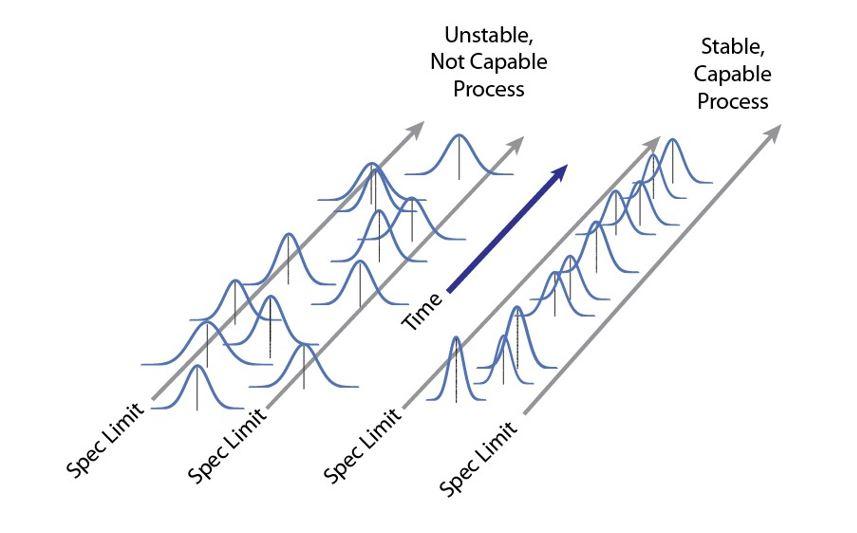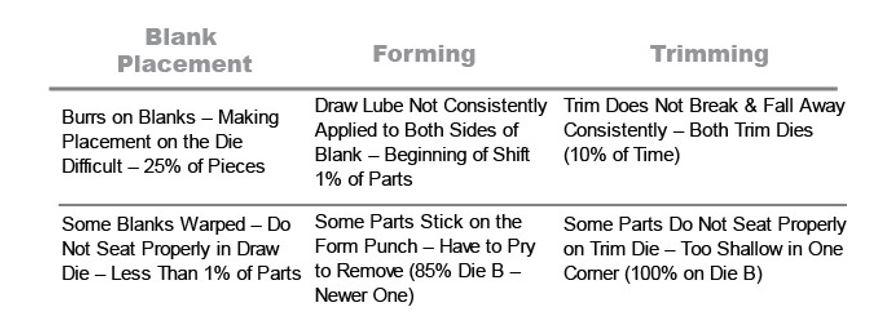Partner
- FMA
- The Fabricator
- FABTECH
- Canadian Metalworking
Categories
- Additive Manufacturing
- Aluminum Welding
- Arc Welding
- Assembly and Joining
- Automation and Robotics
- Bending and Forming
- Consumables
- Cutting and Weld Prep
- Electric Vehicles
- En Español
- Finishing
- Hydroforming
- Laser Cutting
- Laser Welding
- Machining
- Manufacturing Software
- Materials Handling
- Metals/Materials
- Oxyfuel Cutting
- Plasma Cutting
- Power Tools
- Punching and Other Holemaking
- Roll Forming
- Safety
- Sawing
- Shearing
- Shop Management
- Testing and Measuring
- Tube and Pipe Fabrication
- Tube and Pipe Production
- Waterjet Cutting
Industry Directory
Webcasts
Podcasts
FAB 40
Advertise
Subscribe
Account Login
Search
How process variability kills automation in the metal fab shop
Automation requires a highly capable, stable process in metal manufacturing sectors
- By Paul Neblock
- Updated May 8, 2023
- October 30, 2021
- Article
- Automation and Robotics

Automation cannot make the unreliable reliable, especially when the parts entering the automated system aren’t consistent. Variability is the biggest pothole on the way to automating a manufacturing process. Getty Images
So many manufacturers struggle to automate seemingly straightforward operations only to spend months debugging and eventually throwing their hands up in despair. They eventually remove the automation, often spurring a string of disputes with automation suppliers. In almost all cases, failure can be traced back to part-to-part variability or a lack of process stability, neither of which are the automation provider’s responsibility.
In the industry’s fever to automate, organizations are making some fundamental mistakes that result in significant process delays, cost overruns, and sometimes outright failure. They end up producing nonconforming parts or losing production throughput from frequent machine faults. In these cases, automation can actually have a net negative impact on productivity and costs. Even worse, project-specific failures cast automation in an unnecessarily bad light with management such that subsequent projects are rejected.
Fabricators can avoid this scenario by taking steps to identify, understand, and reduce what remains the biggest technical reason for project failure: process variability.
What Is Process Variability?
Part-to-part dimensional variation, the most commonly overlooked and important risk factor for any automation project, involves two components. The first is process capability. Do the parts conform to print specifications 100% of the time? A process capability study provides a snapshot of this capability and is measured as Cpk, a process capability index that identifies the ratio between the print specifications and natural process variability.
The second component is process stability. Does the process remain relatively stable over time? Every process has some natural variability, as shown in the normal distributions in Figure 1. If the process centerline in that distribution shifts over time, does it still yield 100% conforming parts? Unless they provide a turnkey cell or operation, automation providers typically hold the fabricator responsible for process stability.
Deep-draw Case Study in Process Variability
Consider a process in which coil-fed, leveled, cut-to-length blanks are deep-drawn and trimmed. Specifically, blanks are cut to length in-house from preslit coils and positioned for loading into a two-station draw and trim press with appropriate lubrication.
The first station has in-die blank-detection sensors that alert the operator of misfeeds and prevent actuation if a blank isn’t seated properly. The second station has in-die sensors that detect if the formed part is properly seated before trimming. This includes trim splitting and ejection so that the finished part can be reliably removed and placed on an exit conveyor.
A press operator loads each blank into the press, actuates the lubrication system, and moves the part manually between drawing and trimming stations to a basket for finished parts. The scrap is sectioned in the trim die and falls away to a conveyor.
In front of the press is a safety curtain with a fast interlock. Still, the company wants to automate the process for productivity and safety reasons. Operating the press is very demanding work, and business is increasing.
On the surface, this might look like a straightforward pick-and-place automation project. An automated system could precisely place blanks into a die, move the drawn part from the die once ejected, then place it in the trim station (see Figure 2). It could then remove the finished part from the trim die and place it on an outgoing conveyor. With the proper interfaces between robotics, the sensors, and press controls, this project should ramp up without a hitch—right?

Figure 1. A stable, capable process has narrow parameter distributions that all occur well within the process specification limits.
What Could Possibly Go Wrong?
Drawn parts need to be accurate and consistent. Misformed parts might stick in the dies and become scrap. And if automated, such mishaps might cause faults that shut down the operation. For this reason, the company needs to assess the drawing process itself for capability and stability.
Planning for automation requires a keen eye for failure modes: What can and will go wrong? This is the essence of excessive process variability that manifests itself in automation that alarms-out frequently, producing excessive scrap and diminishing throughput.
Three Steps to Reducing Process Variability
A three-step process has proven quite successful to minimize such process variability and roadblocks to automation: (1) observe, (2) analyze, then (3) plan and implement.
- Closely observe the manufacturing process and collect data. A team assigns one draw and trim die set as A and another B. The performance of die set A should match die set B. That’s the ideal, at least. To uncover the reality, a team observes the die set performance over multiple days and shifts. Figure 3 details their findings.
- Analyze the data and observations to identify areas of risk. The team reviews the data collected, identifies and ranks the areas of risk, and conducts root cause analysis to understand the causes of process variability. Process failure mode and effect analysis (PFMEA) can be a good tool to organize this. A simpler version might look like the table shown in Figure 4.
- Plan and implement actions to reduce variability. The team works with others in the organization to implement corrective actions to significantly reduce, if not eliminate, the process variability identified (see Figure 5). They also closely monitor these improvements and their impact, lest process variability raise its ugly head weeks or months later.
Next Steps Toward Automation
The disciplines of lean manufacturing and fundamental process controls (use of statistical process control, capability studies) help improve manual operations, but they become even more important in an automated environment. Once implemented in the manual environment, the transition toward automation can begin in earnest.
Screen Automation Providers. Automation providers are in the business of developing, designing, building, and implementing automated cells. They are not in the business of mitigating process variability and risks. In fact, they expect their customers to have a handle on both. The best providers will spend time on-site, observe the operation, and thoroughly identify risks. Still, do not rely on the automation provider to do this work for you.
If the automation provider is providing a turnkey cell, include in the contract the specific testing required at the factory and during commissioning to approve the project. Together with the provider, closely review the operation, including part location and workholding, to ensure they grasp the entire process, not just the automation.
Some automation companies will want to sell complex vision systems and in-process inspection devices. Be wary of these and focus first on obtaining and maintaining a very capable process. Inspection devices must be calibrated and maintained, and they add cost and cycle time. If these devices end up producing false signal after false signal, they might end up being turned off anyway.
Write a Request for Quote With a Two-stage Approval Process. Include process run-off steps in your contracts, one at the automation supplier’s facility before shipment and one at your factory upon commissioning and before final payment. Be sure to document this two-stage approval while soliciting bids so the automation providers can plan for and include the cost and time in their bid documents. Tie progress payments for each step to the completion of each stage, and clearly define approval requirements, such as specific cycle times and desired uptime.
Conduct In-depth Automation Concept Reviews. Review the proposed automation concepts closely with prospective suppliers. Ask them to walk the team through each station, the proposed concept, and underlying assumptions.
Also, walk through the failure modes your team has identified and with the automation firm, and ask how their proposed solution would address each one. Finally, ask their design team about their concerns about the application. Good designers will have good questions.

Figure 2. The focused steps, outlined in red, look seemingly straightforward to automate—but not without process stability and capability.
Provide Representative Parts for Automation Development and Approvals. After you have tightened up process controls and reduced process variability, provide the selected automation supplier with parts from a number of lots or production runs to use in debugging the equipment at its own facility. The automation supplier will use these during the first approval stage, so avoid sending only the best of the best parts as this will only cause more issues during the second approval stage on-site.
Detect Process Variability Early
Fabricators increasingly turn to automation and smart technologies to address critical labor and skills shortages across the nation. And the pace of automation is increasing, thanks to high demand and reshoring trends in supply chain management. Still, automation by itself cannot make the unreliable reliable, especially when the parts entering the automated system aren’t consistent.
Uncover process variability early in a project so it can be eliminated rather than detected during commissioning. Successful automation is always based on stable, capable processes. Successful fabricators understand this and do the hard work to understand their processes, stabilize them, reduce variability—and only then automate.
About the Author
subscribe now

The Fabricator is North America's leading magazine for the metal forming and fabricating industry. The magazine delivers the news, technical articles, and case histories that enable fabricators to do their jobs more efficiently. The Fabricator has served the industry since 1970.
start your free subscription- Stay connected from anywhere

Easily access valuable industry resources now with full access to the digital edition of The Fabricator.

Easily access valuable industry resources now with full access to the digital edition of The Welder.

Easily access valuable industry resources now with full access to the digital edition of The Tube and Pipe Journal.
- Podcasting
- Podcast:
- The Fabricator Podcast
- Published:
- 04/16/2024
- Running Time:
- 63:29
In this episode of The Fabricator Podcast, Caleb Chamberlain, co-founder and CEO of OSH Cut, discusses his company’s...
- Industry Events
16th Annual Safety Conference
- April 30 - May 1, 2024
- Elgin,
Pipe and Tube Conference
- May 21 - 22, 2024
- Omaha, NE
World-Class Roll Forming Workshop
- June 5 - 6, 2024
- Louisville, KY
Advanced Laser Application Workshop
- June 25 - 27, 2024
- Novi, MI
































